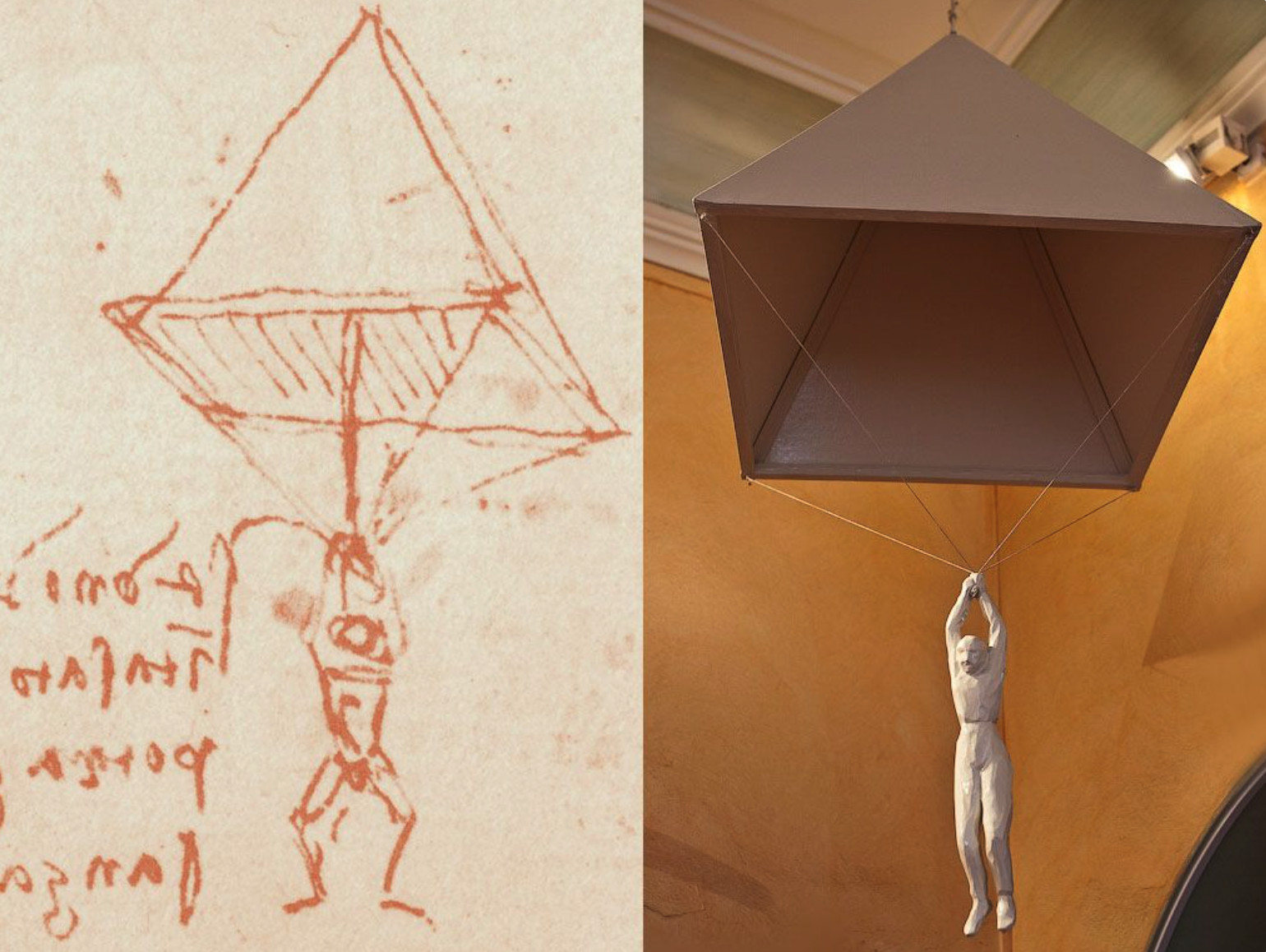If you’ve ever dreamed of tasting flight, you aren’t alone. People have been dreaming that same dream for a very, very long time. The first story of someone using a parachute is dated back to about 86 BC in China! That being said, skydiving as we know it today got its start much later. It’s hard to pinpoint exactly who invented skydiving as lots of people are credited with different important things that led to its development. Let’s jump into skydiving history together, shall we?
Who Invented The Parachute?
All good skydives end with a parachute ride. That beautiful bundle of fabric is what arrests your fall and allows you to end your 120 mph plunge from an airplane with a gentle ascent to the ground. Without it, the end of the skydive would not be nearly as pleasant. So, the invention of the parachute was the foundation of the sport itself.

While the first stories of parachute flight date back to that story from China (that we mentioned earlier), one of the first drawings of a potentially functional parachute came from none other than Renaissance man Leonardo da Vinci in the 15th century. His famous first-parachute sketch features a person suspended from a three-dimensional pyramid-shaped “parachute” constructed of linen cloth and wooden poles. While da Vinci’s ideas were more of a concept than an invention (as the parachute was not actually created at the time), these drawings helped pave the way for the path of human flight.
- Would Da Vinci’s Design Have Worked?
In 2000, Adrian Nicholas sought to answer the same question. He was lifted to about 10,000 feet via hot air balloon, suspended under a parachute built to da Vinci’s specifications. Despite the belief that it wouldn’t work, it did! For safety reasons, Nicholas cut away the da Vinci-style parachute at around 2,000 feet and continued the flight to the ground under a modern parachute.
The First Parachute Jump
It wasn’t until 1783 that the first parachute was actually invented (and tested) by a man named Louis-Sebastien Lenormand. His design was an umbrella-type parachute that he tested by jumping from a tower in France. Using his 14-foot wing, he managed to land unharmed. He thought of his parachute as a possible way to escape a burning building (and in no way involved airplanes).
It wouldn’t be long before people began to test their limits in other ways. The next step in the history of skydiving would require people to take a big one – jumping from distances far higher than the height of buildings. A few years after the first successful parachute design, the first skydive was made by André-Jacques Garnerin from a hydrogen balloon in 1797. He jumped from approximately 3,200 feet above the city of Paris!
Even still, this doesn’t much resemble “skydiving” as we know it today. While people do still jump from balloons (and even helicopters) on occasion, the vast majority of skydives take place from an airplane!

Who Invented The Airplane?
More than 100 years after that first fateful jump, the next piece of the skydiving puzzle was created: the aeroplane (aka airplane). Orville and Wilbur Wright are credited with inventing the first successful airplane taking its first flight by Orville in 1903. On that day in Kitty Hawk, North Carolina, they made four successful flights, paving the way for all-things-air travel.
The First Airplane Jumps
As you can imagine, the first people to attempt skydiving from an airplane were true adventure-seekers. Many had experienced skydiving from balloons, but the fact that the airplane is moving forward when the jumper exits – rather than stationary, like a balloon – made the experience much different.
It is debated as to who actually made the first skydive from an airplane. Credit is split between William Morton and Albery Berry who were said to have completed their jumps in 1911 and 1912, respectively. While the name of the person who completed this first jump is unknown, it doesn’t much matter; it still paved the way for more modern skydiving. The first military parachutists rolled out in 1918 by Italian assault troops, then in 1940 by US troops. By 1951, skydivers were competing in competitions around the world.
Sport Skydiving
With parachuting becoming more popular with the military, it wasn’t long before civilians realized they could know human flight as well. In 1957, the sport parachute was invented by Jacques-André Istel – a skydiving pioneer known as “the father of modern skydiving.” Two years later, he opened the first-ever civilian parachute school in Orange, Massachusetts. Fun fact: that dropzone is still open to this day and goes by the name of Jumptown!
Wishing to share the excitement of skydiving with passengers, Ted Strong invented tandem skydiving in 1983 … and the rest is, well, skydiving history! In 2021, there were 3.57 million sport jumps according to the United States Parachute Association (USPA) – a number that has continued to grow almost every year since the invention of the sport.
Are you ready to take flight? Would you like some more skydiving information? We’re ready to share it with you! Book a skydive today at Skydive California – Northern California’s premiere skydiving center. Blue skies!!







